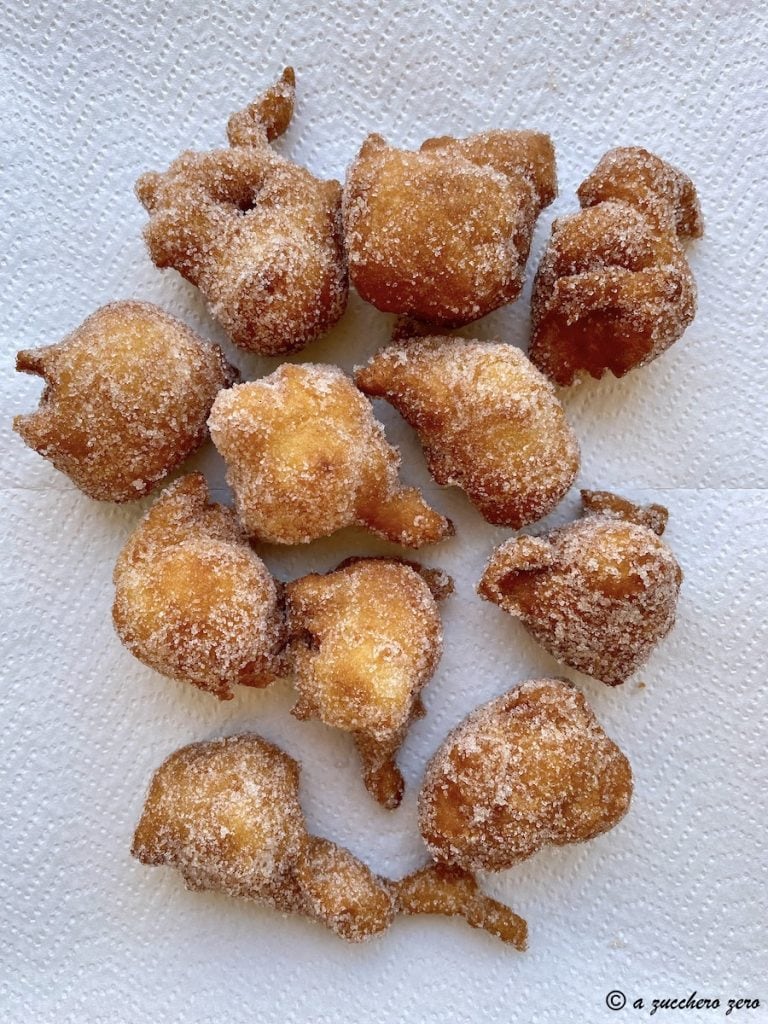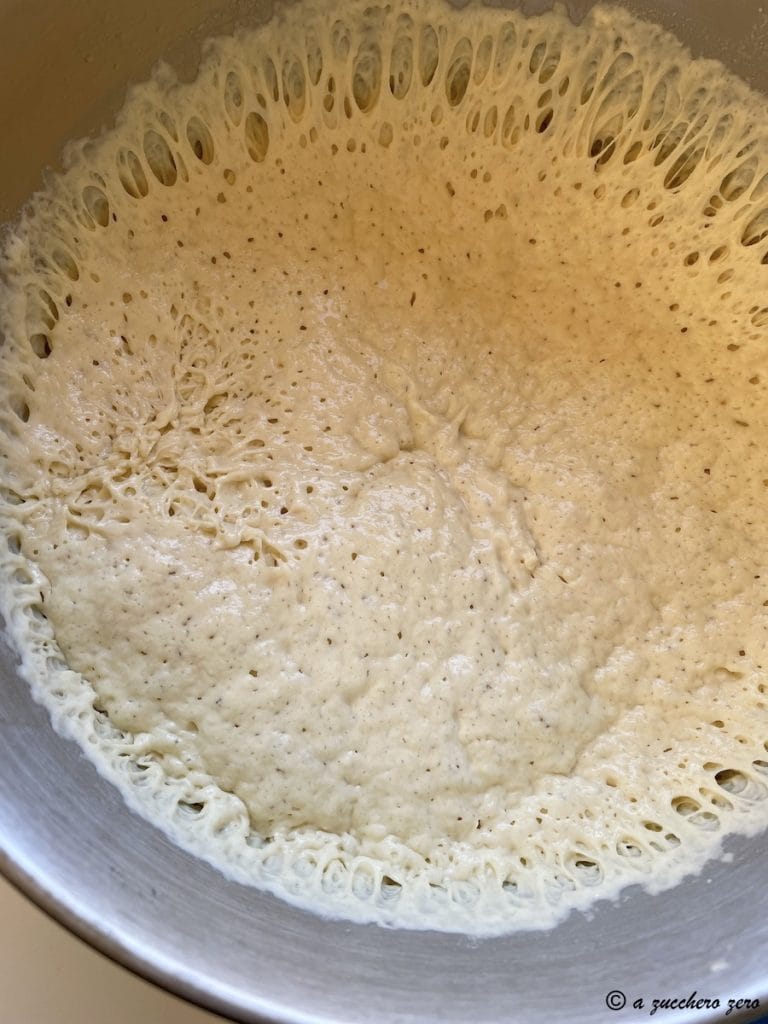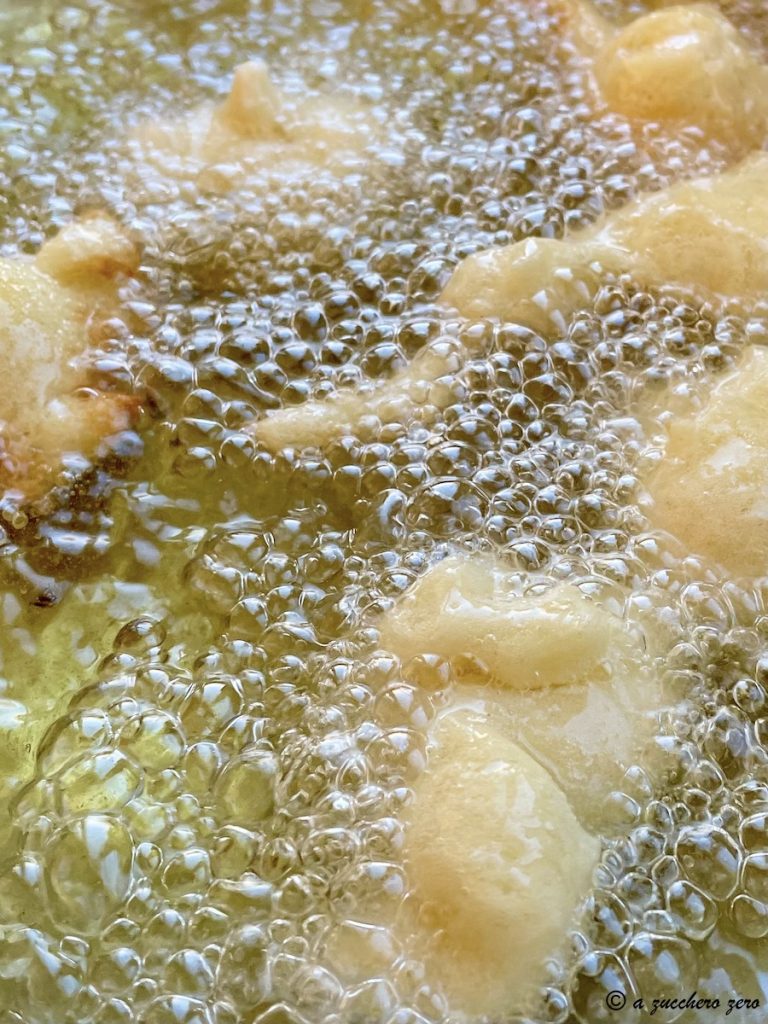Traditionally, in Sicily, fritters or sfinci or zeppole are prepared in November: St. Martin’s Day fritters and during the Carnival period.
!!! I reflected for a long time on whether or not to post this recipe on a blog named a zucchero zero whose theme is diabetes prevention at the table but since it is a family recipe which my mom and I are very attached to, I decided to share it anyway.
It’s clearly an exception, and I hope you’ll forgive me.
Typical sweet leavened dough with raisins and walnuts filling.
Fritters or sfinci or zeppole
My mom’s dough is based on hard wheat semolina, water, and yeast.
A simple dough without butter, without milk, without eggs, and without potatoes just like the original!
Once leavened, you can prepare:
• simple fritters;
• sweet fritters;
• savory fritters.
The Sicilian fritters prepared this way are crunchy on the outside and soft on the inside.
I conclude with a personal anecdote: it was love over St. Martin’s fritters!
The official taster and I started dating on November 12, 2015, right after indulging in a feast of fritters enjoyed in the square with our group of walking friends [when sugar wasn’t an issue yet].

- Difficulty: Medium
- Cost: Economical
- Rest time: 8 Hours
- Preparation time: 20 Minutes
- Cooking methods: Frying
- Cuisine: Italian
Ingredients
- 12.35 oz stone-ground hard wheat semolina
- 0.07 oz salt
- 2 tbsp sunflower oil (or extra virgin olive oil)
- 1 cup lightly sparkling water
- 0.04 oz sugar
- 1 tsp dry yeast
- fennel seeds
- raisins (soaked and squeezed)
- apples (chopped)
- walnuts (chopped)
- chocolate chips
- anchovies (drained and chopped)
- cheese (cubed or diced or shaved)
- sunflower oil
- 1 glass water
- granulated sugar
- cinnamon powder
Suggested Tools
- Bowl for rising with lid
- 1 Pastry board
- Paper towels for kitchen use
- 1 Wok non-stick
- 1 Spoon
- 1 Glass
- 1 Slotted spoon
Preparation
THE NIGHT BEFORE
In a bowl, mix:
• 12.35 oz of stone-ground hard wheat semolina;
• 0.07 oz of salt;
• 2 tablespoons of sunflower oil or extra virgin olive oil to taste;
and combine.Warm 1 cup of lightly sparkling water, it should be warm, not hot.
Add 0.04 oz of sugar to the warm water to activate the yeast and one teaspoon of dry yeast, then mix to dissolve it.Add the water with sugar and yeast as needed [all of it, if necessary] to the dry ingredients and mix until you get a sticky and elastic dough, not liquid.
Seal the bowl with a lid or plastic wrap.Let the dough rise overnight.
Rising times may vary, shortening if temperatures are higher.THE NEXT MORNING
The fritter dough has risen well.
You can prepare:
• simple fritters;
• sweet fritters;
• savory fritters.Do not add anything to the dough.
Add one or more ingredients to the dough to taste:
• fennel seeds;
• soaked and squeezed raisins;
• chopped apples;
• chopped walnuts;
• chocolate chips.Add drained and chopped anchovies and/or a cheese cubed or diced or shaved [cacio cavallo, primo sale, provola, scamorza, grana padano, parmigiano reggiano].
On a work surface or tray, lay a couple of layers of paper towels.
In a wok or non-stick pan, pour and heat plenty of oil for frying [at a temperature of 356°F].
To know when the oil is at the right temperature, drop a bit of dough into it and check if it sizzles.Prepare a spoon or a melon baller.
Prepare a glass of water.Dip the spoon each time, scoop the dough and let it slide into the oil.
Fry the fritters, turning them occasionally until they become evenly golden brown.

Remove the fritters from the oil with a slotted spoon, draining them well and transfer them to the sheets of paper towels.
Continue preparing the fritters until the dough is finished.
Replace the paper towels when they become soaked with oil.Traditionally, sweet fritters are coated in plenty of granulated sugar.
In a bowl, mix granulated sugar and cinnamon.
Coat the fritters with sugar and cinnamon, allowing the excess to fall off.
My secret to make sugar adhere as little as possible is to hold the fritter by a tip and sprinkle it from above so that enough adheres and the rest slides down.Your Sicilian fritters St. Martin’s fritters or Carnival fritters simple, sweet, or savory are ready.
Enjoy your meal!
We consider fritters a treat [primarily due to the cooking method] to be enjoyed at the end of a meal in limited quantities.
In case of hyperglycemia, it is at least advisable to avoid adding raisins and refrain from coating them in granulated sugar.
• low glycemic index dough for fritters to bake in the oven.
FAQ (Frequently Asked Questions)
What flour can I use to replace hard wheat semolina?
The original recipe uses hard wheat semolina.
Alternatively:
• semolina and flours with a low glycemic index.Why sparkling water in the dough?
Sparkling water makes the dough lighter and fluffier.
You can also use still water without any issue.St. Martin
November 11 is St. Martin’s Summer day
The expression refers to an autumnal period of good weather and is linked to the legend of Martin: it is said that, on an autumn day, probably November 11, the saint gave part of his cloak to a poor man, and the sun came out afterward.
Source: tg24.sky.it.
The occasional St. Martin’s Day dessert is a large round cookie: viscotta di San Martinu or sammartini or sanmartinelli, and to preserve the sacred traditions of the ancestors, it must be dipped in wine.
Source: Enrico Onufrio.
St. Martin and the beginning of the agricultural year
U bonu siminatu a menzu novemmaru è cuminsatu: sinu a san Martinu favi, puseddi e linu; doppu san Martinu, megghiu ‘n terra ch’o mulinu.
The good sowing before mid-November has begun: until – the feast of – St. Martin – sow – beans, peas, and flax; after St. Martin – the wheat – is better under the earth than in the mill.
On St. Martin’s Day, open the cask and taste the wine.

